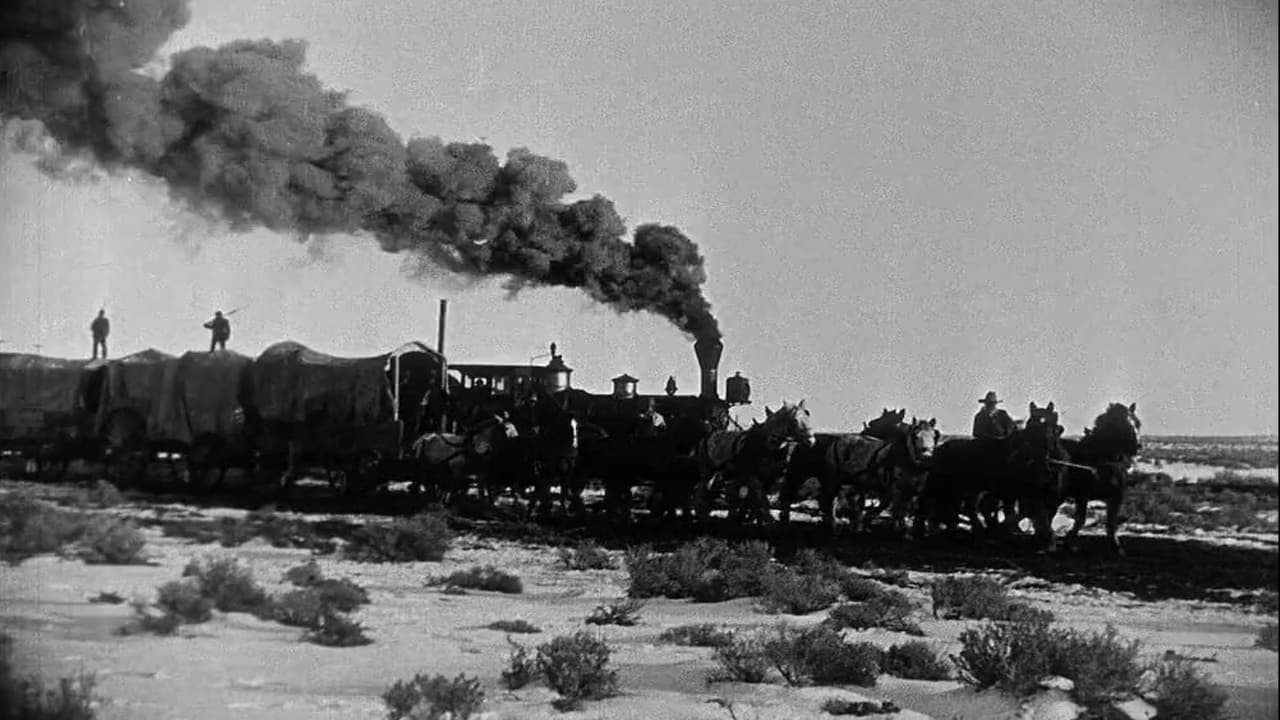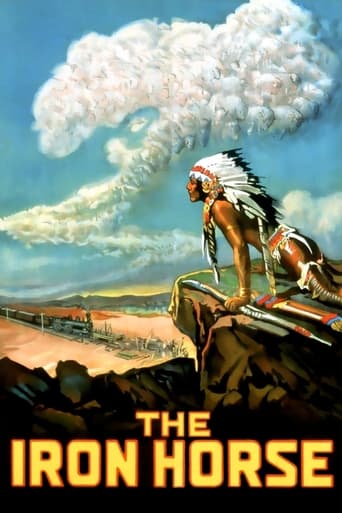

Self-important, over-dramatic, uninspired.
... View MoreBrilliant and touching
... View MoreI didn’t really have many expectations going into the movie (good or bad), but I actually really enjoyed it. I really liked the characters and the banter between them.
... View MoreA clunky actioner with a handful of cool moments.
... View MoreJohn Ford's breakthrough Western epic blazed a trail for one of American cinema's major figures, so I really wanted to like it. But this is a film less about history than it is history, a dusty collection of tropes and sentimentality that falls well short of Ford's timeless standard.The movie opens in Springfield, Illinois, where we see a man puffing at his pipe as he looks off in the distance. "Having another of your day dreams about rails across the continent?" his neighbor laughs expositionally. Eventually the dreamer is killed by Cheyenne, but not before finding a deep cut in a mountain range that will simplify the building of a national railroad. It's up to his son to see his father's dream become reality.Silent films don't age equally well. Horror films and comedies hold their value, even improving in some instances. Period dramas and mysteries that require a fair amount of talking to move the plot, on the other hand, often do not. Silent films are great at establishing mood, but often struggle at meaning."Iron Horse" is a good example. Because you can't hear people talking, you need their expressions to tip you off on what's going on. Some silent directors struck a good balance; Ford here doesn't. The opening Springfield section is full of over-emoting, whether it's the scoffing neighbor or the icky tears of a lovestruck girl. One creepy tall guy stares intensely at two children for minutes on end, but it's okay because he's not a perv but our 16th president, just a log-cabin lawyer here but one who shares the dreams of an express to California.Poor Abe never had any luck with theatrical presentations. Here he seems to be trotted out as Ford's seal of approval, a leaden figure who moves through the early story like Christ in a Passion Play. The film also has two dedications to Lincoln, and a bas-relief image of the man superimposed between them. I admire the man enormously, but enough already.As an epic Western, "The Iron Horse" gets as much spectacle in as possible. This includes some memorable shots. One I often see in Ford and western retrospectives is of sunlit boxcars suddenly being darkened by the shadows of Indian warriors. Ford also uses perspective to great advantage, like a slight overhead of a Pony Express rider being chased by Indians, or a buffalo herd stampeding into frame.That buffalo herd is part of the problem, too. It's very loosely connected to the rest of the movie, a bit of explanation about how rail-building crews were fed. Otherwise, you need it as much as a cattle run glimpsed later in the film or the seduction of a character we already know is going to turn out bad. Ford liked to futz around in his movies with various ancillary tangents, but there's something about a silent that makes such an approach very slow viewing.The best thing in the movie by far is star George O'Brien, playing Davy, the son of the dreamer all grown up. When he finally arrives in the 45th or 55th minute (depending on whether you are watching the European or longer American version), he provides a natural, affable presence the movie sorely lacks. Before he comes riding in, you are stuck between the eyelash-batting heroine Miriam (Madge Bellamy) and the eyebrow-cocking comic relief of Casey (J. Farrell MacDonald), representing two poles of very bad acting.The central problem with the movie is how ridiculous its story is. The DVD cover quotes Leonard Maltin approvingly: "This movie invented what later became clichés." Without getting into spoilers, I ask you to ponder the real identity of the lead villain, or the goofy way the heroine decides to hold it against Davy for exposing her fiancé as a lying heel. "You promised me and you've broken - your word" she tells him, whereupon he bows his head mutely.If it was a sound film, he could have chewed her ear off making a case for himself. What you are stuck with here instead is an insipid and uninvolving melodrama relieved occasionally by a cool gun battle or a nice horizon line. "Iron Horse" shows Ford starting out with little more than a good eye and a taste for grand spectacle still somewhat beyond his powers to corral.
... View MoreAn amazing film for its scope, visuals and acting.We get to see many of John Ford's classic trophes in this film: the interplay and comic relief of European characters, great bar scenes and wonderfully photographed Indian action. The white man masquerading as an Indian becomes a common cliché, though, in many future westerns. It turns out that the classic long shot of seeing riders crossing the crest of a mountain was already old, having been used in how many of the westerns, and countless more to come, including 'The Vanishing American' (1925) which was filmed in Ford's beloved Monument Valley.The film's biggest problem is that Ford's passion for history gives us too many intertitles that interfere with and slow down the action-- especially at the end.But this film is so worth seeing for its vision, scope and execution. I give it an 8.
... View More"The Iron Horse" is the first trans-American railway system; the story of its construction is told in this film. Chief among the other plot lines is the love story featuring hero George O'Brien (as Davy Brandon) and heroine Madge Bellamy (as Miriam Marsh). Villainous Cyril Chadwick (as Peter Jesson) comes between them. Will Mr. O'Brien and Ms. Bellamy come together? Will the Central Pacific railroad and the Union Pacific railroad hook up? Only time will tell This film takes a long, long time to pick up steam. Star O'Brien (and many regular cast members) appear only after a prolonged prologue. Some of the supporting cast are dispensable, like the unfunny "three musketeers". Fortunately, "The Iron Horse" is expertly directed by John Ford; and, lead actor O'Brien is very appealing. ****** The Iron Horse (8/28/24) John Ford ~ George O'Brien, Madge Bellamy, Charles Edward Bull, Cyril Chadwick
... View MoreTHE IRON HORSE is a plot heavy western with what appears to be an authentic historical background, well photographed in crisp B&W photography that is not as primitive as one might expect from a film made in 1924. It bustles with excitement whenever any action scenes are taking place, accompanied by a "silent" music score that actually fits the story and never becomes tiresome.GEORGE O'BRIEN has the lead but doesn't enter the film until at least fifty minutes is taken up with a prologue involving old Abe Lincoln himself and the friendship of two children who are soon separated but destined to meet again midway through the story when they're adults. The girl is played as a young woman by MADGE BELLAMY. She and O'Brien become romantically attached although she's now the fiancé of one of the villains of the piece. There's also a subplot involving the man who killed O'Brien's father, Bauman (FRED KOHLER), who is a white man joining the Indians for attacks on the "iron horse".Some of the acting is strictly silent film technique and there's the usual John Ford inclusion of comedy relief from actors like J. FARRELL MacDONALD, long stretches of captioned "talk" for scenes that run too long with exposition, but decent work from O'Brien and Bellamy as the leads.It's pioneering in the Ford mold, obviously a film that employed a huge cast to portray the building of the Union Pacific railway to the west, telling a fictional story of romance and danger with authority.Worth viewing, although at two hours and ten minutes it can sometimes try your patience. All the hard work that went into the making of the film is evident throughout.
... View More